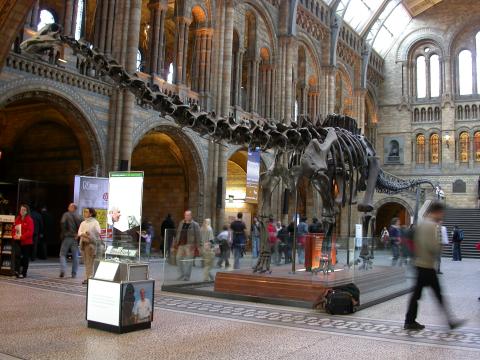
[Click for high-resolution version; see below for permissions]
2nd March 2011
The main purpose of this page is to provide images that can be used by print media and television. See also the extras page, which contains high-resolution images from the paper itself. In particular, figure 1, which shows the neck and head of a hare in "neutral" pose and in the much higher pose that the hare habitually adopts, may be of interest.
Click on any image for a larger version; see below for image credits, copyrights and permissions.
The sauropods were the largest of all the dinosaurs, attaining lengths of over 30m and weighing up to 70 tonnes -- ten times as much as a large African elephant. Sauropod skeletons are spectacular fossils and form the centerpieces of many museums. For example, here is Diplodocus in the Natural History Museum, London:
And a different mount of the same animal in the Humboldt Musuem für Naturkunde, Berlin:
And here is Brachiosaurus in the Humboldt Musuem für Naturkunde, Berlin (with me for scale, down by its left elbow):
Sauropods are immediately recognisable by their very long necks, which carry small heads. But the question of how they held those necks has been the subject of debate for the best part of a century. Some workers have reconstructed upright or at least inclined necks, like that of the Brachiosaurus skeleton above, while others have favoured low, horizontal necks like that of the Diplodocus skeleton.
In recent years, the horiontal-necked posture has become widely accepted, especially as a result of the DinoMorph project of Kent Stevens and Michael Parrish (1999), in which computer models of sauropod skeletons are positioned so that consecutive neck vertebrae fit together as well as possible. This has been called "neutral pose". The image below illustrates neutral pose for Diplodocus, along with the highest and lowest positions that, according to Stevens and Parrish, the neck could achieve:
These low-necked poses have been widely publicised, especially through their use in the BBC's Walking with Dinosaurs. Here is a cover image, and set of eight screen-captures showing the pose used for Diplodocus:
But is the low-necked posture correct? As shown by a new paper (Taylor, Wedel and Naish 2009), there are two problems with the DinoMorph model.
First, it shows an unrealistically restricted range of motion. The neck vertebrae of sauropods fit together mainly by a ball-and-socket joint, but in addition to this each vertebra has a pair of facets, two in front and two at the back, which also touch in adjacent vertebrae. When the neck bends, these facets glide past each other. Stevens and Parrish assumed that each pair of facets must maintain at least a 50% overlap at all times; but observations of the necks of ostriches and giraffes show that in fact their facets can slide much further, until they hardly overlap at all. So the range of motion would really have been much wider than depicted here.
Second, it has been assumed that neutral pose corresponds to the way the live animal habitually hold its neck; but this is not what live animals really do. Here, for example, is an X-ray of a cat (facing left; head at top left, torso bottom right):
In typical posture, the cat's neck is bent strongly upwards at the shoulder and strongly forwards at the head, so that the main part of the neck is vertical -- and in fact even inclined slightly backwards. This is not apparent when we see a live cat, because the arrangement of soft tissue around the neck vertebrae hides how strongly they are deflected from neutral pose: X-rays are needed to see what the bones are doing. This erect neck posture is not unique to cats, but is seen in all sorts of animals -- for example, here are rabbits, in semi-alert and resting postures:
More important, this posture is not restricted to mammals, but is particularly pronounced in the dinosaurs' closest living relatives, the birds. Here is a chicken (and again, this posture in living chickens is rather obscured by the soft tissue):
The same effect is present, though to a lesser extent, in crocodilians, lizards, turtles and even salamanders -- in short, in every group of tetrapods (that is, vertebrates other than fish). But it is strongest is mammals and birds.
What does this mean for sauropods?
First, unless sauropods carried their heads and necks differently from every living group of land vertebrates, we have to assume that the bases of their necks were habitually curved upwards, and that their heads were inclined strongly downwards.
Second, since sauropods' closest living relatives, the birds, take this posture to an extreme, Occam's razor suggests that we should expect the same to be true of sauropods. In some sauropods, this could have meant that they habitually held their heads and necks in a graceful swan-like S-curve. Even in their relatively inflexible-necked relatives like Diplodocus, the neck was probably held noticably elevated, as in the following images. (These are all variants of the same illustrations, varying only in that one shows bones only, one also shows the outline of soft-tissue, and one shows only a silhouette.)
Here is an illustration by Mark Witton, showing a herd of Diplodocus in what we think would have been their habitual posture.
Here is a photograph of me (Mike Taylor) inspecting the horizontally-mounted neck of the sauropod Cetiosaurus oxoniensis at the Leicester City Museum.
Finally, TV and radio stations potentially interested in interviewing me about this work may be interested to see some of the interviews I did when the then-new sauropod dinosaur Xenoposeidon was announced in November 2007. Videos of a live interview on Channel 4 News and filmed spots on ITN, CNN, BBC South, Meridian and Televisa (Spanish language) are available on my YouTube page at http://www.youtube.com/profile?user=Mirk101&view=videos
Here are the references to papers and presentations I've mentioned on this page: